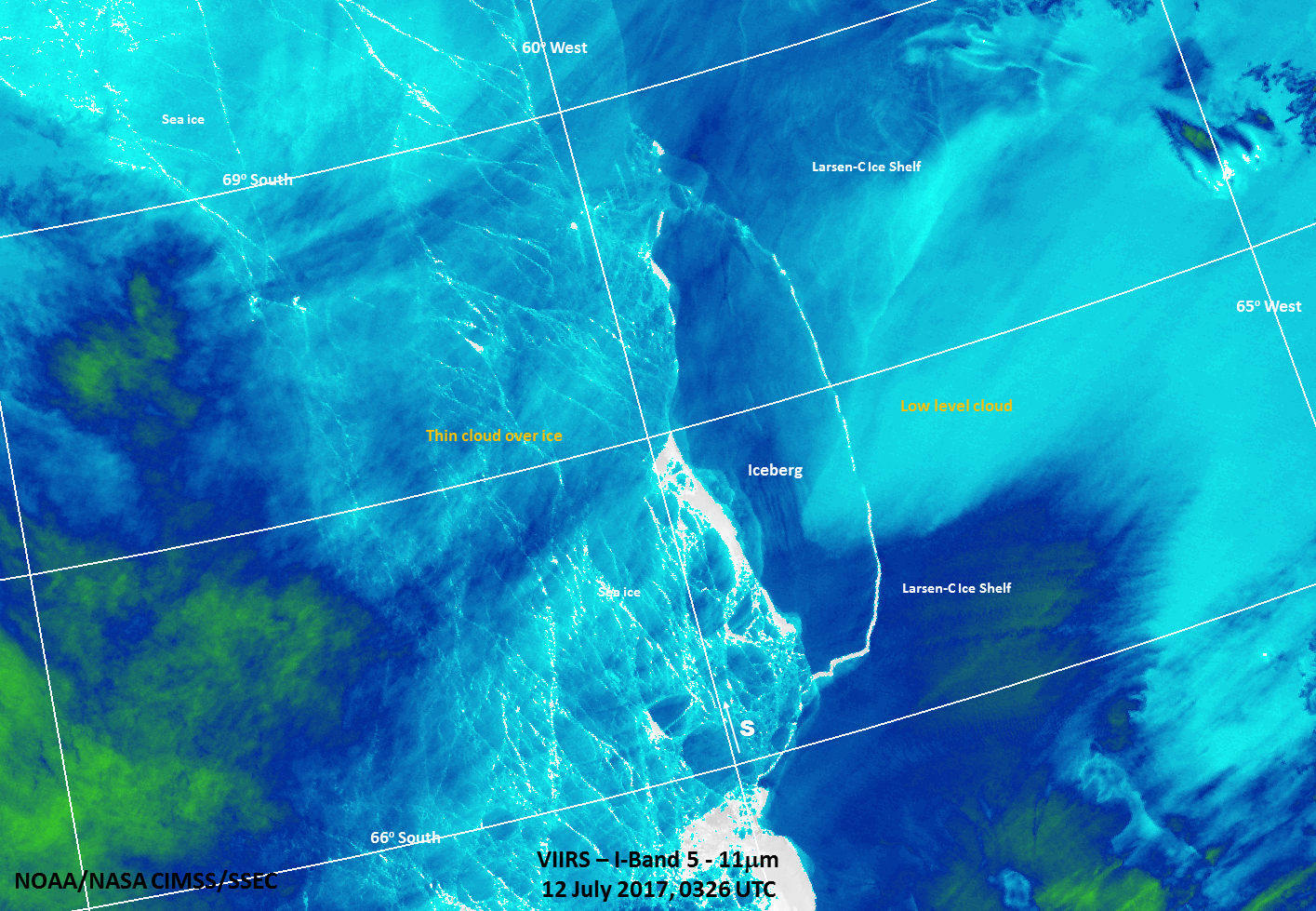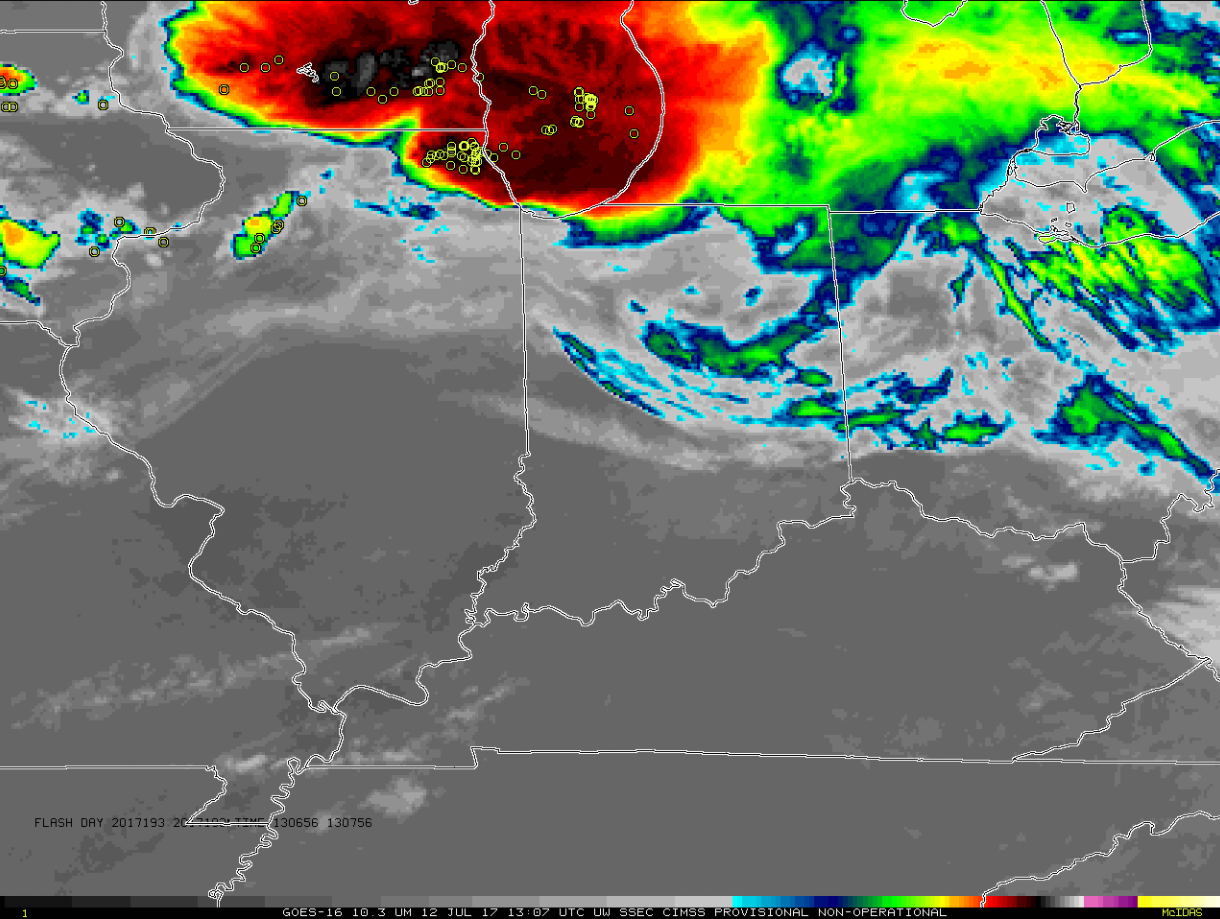
[ Archive ]

 |
CIMSS-NOAA Weekly Report [ Archive ] |
 |
ASPB AND CIMSS WEEKLY HIGHLIGHTS FOR THE WEEK ENDING JULY 14, 2017
IN THE PRESS:
SSEC Meteorologists Provide Commentary on Antarctic Iceberg: Scientists from the Antarctic Meteorological Research Center (AMRC) at the University of Wisconsin-Madison's Space Science and Engineering Center (SSEC) talked with local reporters about the Delaware-sized iceberg that broke away from the Antarctic Peninsula this week. Stories included: 1) Matthew Lazzara: interviewed on Wisconsin Public Radio's Central Time program (http://go.wisc.edu/7mp6tf), 2) David Mikolajczyk: interviewed on WISC's (CBS) Live at Four program (http://go.wisc.edu/s9aqd9), 3) Lee Welhouse: interviewed on WMTV (NBC) news program, air date to be determined, 4) Lee Welhouse: interviewed on WKOW's Capital City Sunday program which will air 16 July 2017 on Wisconsin ABC affiliates in Madison, Wausau, La Crosse, and Eau Claire. (Jean Phillips, SSEC, 608-262-8164)
 (Click image to enlarge)
(Click image to enlarge)
Figure caption: VIIRS image of the iceberg from Larsen-C ice shelf on 12 July 2017, 0326 UTC. Credit: William Straka, CIMSS.
ITEMS FOR THE ADMINISTRATOR:
ITEMS FOR THE ASSISTANT ADMINISTRATOR:
ITEMS FOR THE OFFICE DIRECTOR, STAR:
Many VIIRS Enterprise Products are Now Operational: Many VIIRS “Enterprise” products became operational in NESDIS on July 5, 2017. They include Ice Concentration and Cover, Ice Surface Temperature, Ice Thickness/Age, Snow Cover, Fractional Snow Cover, Aerosol Detection, Aerosol Optical Depth, Aerosol Particle Size, Volcanic Ash Mass Loading, Volcanic Ash Height, Cloud Mask, Cloud Top Phase, Cloud Type, Cloud Top Height, Cloud Top Temperature, Cloud Top Pressure, Cloud Optical Depth, Cloud Particle Size Distribution, Cloud Liquid Water, and Cloud Ice Water Path. The cryosphere, cloud, and volcanic ash product teams are lead by Advanced Satellite Branch (ASPB) scientists. In addition to the science improvement gained by the development of the Enterprise (NOAA-unique) products, they also demonstrate NOAA’s goal of enterprise solutions by employing same algorithms for POES and GOES satellite systems. (J. Key, E/RA2, 608-263-2605, jkey@ssec.wisc.edu; A. Heidinger, E/RA2, 608-263-6757, andrew.heidinger@noaa.gov; M. Pavolonis, E/RA2, 608-263-9597, mpav@ssec.wisc.edu)
IGAC IBBI Conference Presentation: Brad Pierce presented a talk entitled "NOAA JPSS and GOES Fire Products" at the World Meteorological Organization (WMO) International Global Atmospheric Chemistry (IGAC) Interdisciplinary Biomass Burning Initiative (IBBI) workshop in Boulder, CO on July 10, 2017. The primary goal of the workshop was to improve atmospheric composition and air quality monitoring and forecasting through better scientific understanding of the various processes around biomass burning, with a focus on upcoming field campaigns focusing on western US wild fires. The presentation provided an opportunity for the international biomass burning community to better understand what NOAA does to support fire detection and smoke transport processes(R.B. Pierce, E/RA2, 608-890-1892, brad.pierce@noaa.gov)
ITEMS FOR THE DIVISION CHIEF, CoRP:
Educational workshop given at the Native Youth Community Adaptation Leadership Congress: A workshop on tracking severe weather, wildfires and phenology was given to Native American high school students from the CONUS, Alaska, Hawaii and American Samoa at the Native Youth Community Adaptation Leadership Congress at the U.S Fish & Wildlife National Conservation Training Center. The workshop was sponsored by several federal agencies including NOAA. The workshop included an introduction to applications of GOES data. A list of web sites and mobile Apps with NOAA products was developed and presented at the workshop is available at http://www.ssec.wisc.edu/~rabin/national. (R. Rabin, NOAA/NSSL and CIMSS, 608-264-5325/405-366-0583)
New Posts on the CIMSS Satellite Blog: A number of new posts were added to the Cooperative Institute for Meteorological Satellite Studies (CIMSS) Satellite Blog (http://cimss.ssec.wisc.edu/goes/blog/), including 1-minute Geostationary Operational Environmental Satellite (GOES)-16 Advanced Baseline Imager (ABI) and Geostationary Lightning Mapper (GLM) data of severe thunderstorms in the Upper Midwest, calving of the large A-68 iceberg from the Larsen-C ice shelf in Antarctica, undular bore wave features in Lake Superior, and fires in southern California. (S. Lindstrom, CIMSS, 608-263-4425, S. Bachmeier, CIMSS, 608-263-3958, W. Straka, SSEC, 608-262-5128)
 (Click image to enlarge)
(Click image to enlarge)
Figure caption:GOES-16 ABI Band 13 (“Clean Window”) 10.3 µm Imagery, every minute from 1000 – 1359 UTC on 12 July 2017, with GLM Lightning Flash locations for each minute (yellow circles) superimposed.
GOES-16 Training at the Milwaukee Sullivan National Weather Service Forecast Office: Jordan Gerth and Scott Lindstrom, both at UW-Madison CIMSS, spent 11 July and 13 July, respectively, at the National Weather Service office in Sullivan, Wisconsin, giving in-person GOES-16 training to pairs of forecasters (Mark Gehring / John Gagan, and Steve Hentz / Sarah Marquardt, respectively). The training consisted of a review of the GOES-16 ABI Bands as presented in AWIPS, discussions on the different color enhancements that are available, and instruction on the individual band's utilities as related to the weather on the days when the training occurred. The Channel Differences available in AWIPS, and the Simple and Advanced Red/Green/Blue Composites in AWIPS were also described in depth, with current examples pertinent to the weather on the training days discussed. Finally the GOES-16 Baseline Products available in AWIPS were demonstrated and related to current weather. The training concluded with the students constructing AWIPS Procedures to take advantage of GOES-16 Capabilities in AWIPS. These were the first two of multiple training sessions that will continue into September. (J. Gerth, CIMSS, 608-263-4942 and S. Lindstrom, CIMSS, 608-263-4425
VISITORS:
NEXT WEEK:
LOOKING AHEAD:
| Archived Weeklies Page | Submit a report item |